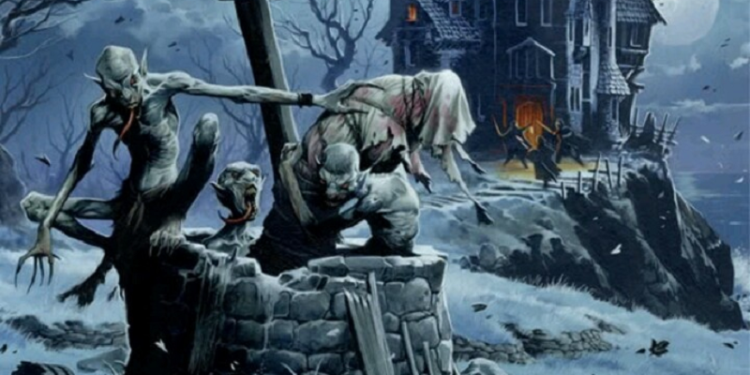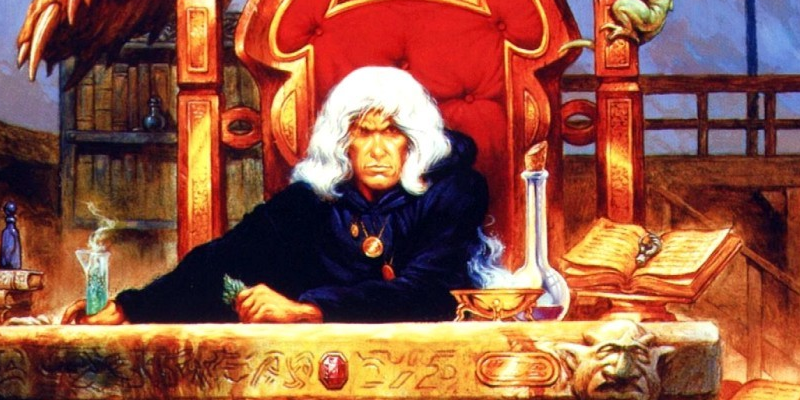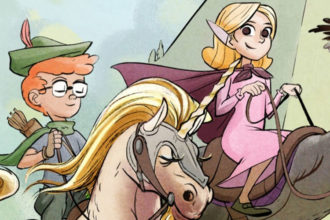Alternative Lore for 5e Ghouls

The history of ghouls in D&D is an interesting one. Since roughly the beginning of time – as counted by editions of D&D – ghoul paralysis doesn’t work on elves. Ghast paralysis – which has been poison in past editions – worked on elves just fine, however. Looking into the history of this, a lot of the commentary states Chainmail is the root of this phenomenon. Both Pathfinder and Dungeons & Dragons 5e have added their own lore to make sense of this rule tradition, but it’s probably not going to be everyone’s cup of tea. To that end, let’s look at examples of alternative lore for 5e ghouls.
History of Ghouls and Elves (in Brief)
Looking into the Chainmail rules indicates Chainmail might not be the sole culprit. Ghouls are the same class as wights, and their paralysis affected all normal figures. Elves and faeries are the same race, and nowhere was it explicitly stated they were immune to ghoul paralysis. Elves were fantastic creatures – judging from the phrase “other fantastic creatures” – but they are normal size and don’t have the strange “these count as X figures” statement. It’s also unclear if creature is the same as figure, since figure is used to refer to units like footmen figures, light horse figures, and so on. Regardless, what we do know is that ten years ago, Gary Gygax addressed this phenomenon in a message board post. According to him, elves were immune to the effect because ghouls used negative energy to paralyze creatures and elves had a boatload of positive energy, thus making them immune.
In 5e, ghouls and ghasts are the work of Orcus. Doresain was an elf worshipper of Orcus who ate a bunch of dudes in order to honor his lord. Orcus was all, “yeah bro, good shit,” and turned Doresain into the first ghoul. Doresain became a lieutenant of Orcus and went around turning other Orcus-worshippers into ghouls, but then got beat up by Yeenoghu – the Demon Lord of Gnolls – losing his position as Ghoul Lord. Orcus didn’t care, which made Doresain even more depressed. Doresain cried to the elven gods for help. The elven gods said, “ugh, fine,” and allowed Doresain to come hang out with them as a no-longer-Ghoul-Lord. Oh, and elves became immune to ghoul paralysis as a result of the gods’ compassion. The last part seems weird, but I have players trying to fix an astral ship made of stone and blessed by Egyptian gods. So.
Non-Standard Customization
This is fine as lore blurbs go. You can dig into existing D&D history if you want to highlight the Demon Lords of the Abyss as an on-going concern for your game or campaign. You can also just ignore it and never worry about the whys of this particular question. It’s only when you are playing outside of established D&D cosmology that something like “elves are immune to ghoul paralysis” stands out as a weird artifact of both previous editions and core setting. You can always just remove that oddity and have elves affected by the paralyze. That’s certainly the easiest option, and one that doesn’t require any extra effort…but where’s the fun of that? Half the fun of being a DM is working with what’s there and finding a way to make it all make sense for the story you are telling.
Alternative Lore for 5e Ghouls – A Wizard Did It
Everyone’s a fan of evil, experimental wizards. In the case of ghouls, it’s easy to imagine an elven necromancer was experimenting with creating new types of undead. If the wizard was ultimately benevolent and just made some bad choices, the ghouls exist to defend the wizard’s people or nation from a vicious threat. Ghouls eat the flesh of the dead in order to stave off the diseases and complications that arise from having too many corpses rotting in your land for too long a time period. It also allows the ghouls to work as stealth forces, both destroying any evidence of a combat and feeding the troops. The wizard used her own blood in the creation of the first ghoul, ensuring the potent necrotic energy wouldn’t affect the other ghouls or their elven masters.
Subsequent ghouls arise from wizards attempting to reproduce the success of the elven ghouls. As a result, all ghouls carry this same flaw with them – regardless of the race of the corpses or wizard animating them. It’s possible wizards could rediscover the original process used to create ghouls, but the elven wizard’s notes no longer exist. Ghasts are a result of experimentation by other races, and most consider them to be dangerous failures. Elves were no longer safe from their touch, but ghasts are not as malleable as ghouls and are a much bigger threat to those creating them. Not an ideal combination, to say the least.
Evil Wizards!
If the wizard was malicious, the wizard creates the ghouls as an invading army that would never need to sleep or eat. Ghouls cannot effectively turn against the conquering elves, as the wizard ensured the touch of the ghouls would never work against the elves leading them into battle – nor against other ghouls, should one of them become controlled by the opposition. Only elven wizards knew the secrets to creating ghouls, and scads of them were creating during the expansion of their empire (or during whatever war they were waging that resulting in them conquering someone.) When the elves fell – or the wizards died – many ghouls escaped the bonds of their masters, and escaped into the wild. In doing some, some of the ghouls regained a sense of self, no longer being mindless undead slaves of the elves.
These ghouls became known as ghasts. As they regained their sentience, ghasts found the magic that limited their efficacy against elves faded. Ghasts possess a measure of control over ghouls they encounter, the elves consider them a palpable threat.
No, Wait. The Gods Did It
If wizards didn’t do it, a different spin on “the gods did it” isn’t out of the question. If you want to draw from stories told in real-world mythology, having the gods argue about which of their children are the best is a good start. The different gods each argue their creation is the best, as gods are wont to do. One of the gods – probably a trickster god or a god of magic (those are always the biggest assholes, we all know it) – declares a challenge: each of the gods select a hero to represent them and compete in a series of challenges. One challenge finds the heroes attending a meal with a foul being who approaches them under rules of hospitality. The heroes, believing this to be the challenge, dine with the creature, even when it becomes clear the meal is people.
Not wishing to be inhospitable, most of the heroes continue to eat the meal – forcing themselves to finish despite the horrible agony of transformation they are now enduring. Only the champion of the elves refuses to partake in the meal, even though it was rude to do so. As the heroes transform into horrific undead monsters – ghouls – the elven hero attacks their host, breaking the rules of hospitality. The host reveals itself to not be a foul creature, but rather the god who proposed the challenge in the first place. The heroes revert to their normal forms, and the god informs them the challenge wasn’t one of hospitality, but one of knowing when to contest hospitality and niceties. To reward the hero, ghouls never pose as much threats to elves as the other races.
Gods In Love
Not all mythological stories are about punishing heroes and their flaws, however. Some are just about all-too-mortal flaws of the gods. Another option for the creation of ghouls could stem from a forbidden or unrequited love between a god of undeath and a god of elves. The god of undeath wished to prove its love to the elven god, doing the most romantic thing it could think of – creating horrible monsters. The god of undeath thought itself clever, as these creatures would provide a challenge to others who were not elves, allowing the elves to shine in defeating them. This either did or didn’t work as you prefer. Ghasts are the result of the god of undeath reacting against the elven god’s rejection, a work to undermine the god of undeath by another god, or a second try at the same plan to win the elven god’s affection.
This might sound strange, but this is basically just how it would work if the gods were Greek, Roman, or Norse. Well, this has less sex in it. You can add more sex for real-world mythological accuracy, I suppose. You do you.
Ghouls and Tin Foil Hats
One final suggestion for alternative ghoul lore is a conspiracy theory. Why are elves immune? To make it look like elves participate in the creation of ghouls. A different race – probably humans (we’re the worst) – grew tired of the perceived perfection of the elves and wanted to put a stop to it. A cabal set the plan into motion, creating the first ghouls. The creation of ghasts followed soon after, allowing independent agency to control the ghouls and sow havoc without it tracking back to the cabal. Populated areas saw an influx of ghouls, allowing for the public to witness the immunity of the elves. Discontent and mistrust grew, resulting in a schism between other civilized races and the elves. Rumors of the conspiracy still abound, but are thus far unproven. This could serve as a central conceit of gameplay – uncovering the conspiracy or working to keep it secret.
Further Weirdness
There is nothing wrong with the lore as written, but setting specific lore is always tricky when translating quirks to other games at large. Personally, I find the history of ghouls absolutely fascinating. It’s a living case of retrofitting an artifact of early editions to modern additions. This is always interesting, as the lore that develops around the rules either supports the rules firmly, or is an obvious attempt at taping something together. Here, the lore as written is a bit of both. The core story is absolutely serviceable and compelling – if specific. The landing just isn’t stuck, and the judges knock down the score by half a point (the Russian judge knocks down the score by a further two points.)
Feel free to speculate on other potential lore for ghouls in the comments, or suggest other weird artifacts that carried over from other editions and need this sort of retrofitting. I eat this stuff up!



